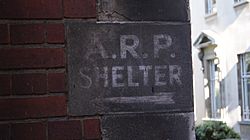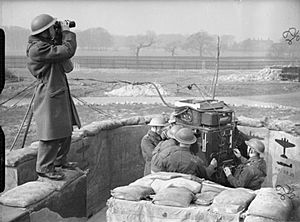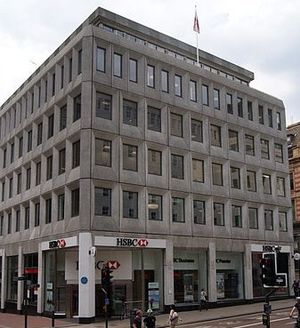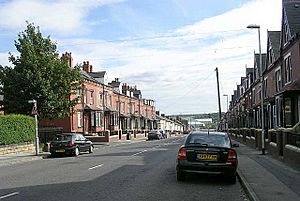Leeds Blitz facts for kids
Quick facts for kids Leeds Blitz |
|||||||
|---|---|---|---|---|---|---|---|
| Part of the Strategic bombing campaign of World War II | |||||||
 Directions to an ARP shelter at the University of Leeds |
|||||||
|
|||||||
| Belligerents | |||||||
The Leeds Blitz was a series of air raids on the city of Leeds by the German air force, called the Luftwaffe. These attacks happened during World War II. The biggest and most damaging raid took place on the night of March 14-15, 1941. It hit the city centre and areas like Beeston, Bramley, and Armley. While Leeds had other smaller raids, the March 1941 attack caused the most damage. It even destroyed parts of the city's museum and its valuable items.
Contents
Why Leeds Was a Target
Leeds is a large city in the industrial heart of West Riding of Yorkshire. It was a very important place for business, government, and factories in the region. Leeds was also a major train hub. Many factories around the city changed what they made to help with the war effort. For example, Avro at RAF Yeadon (now Leeds Bradford Airport) built Lancaster bombers. Other places like Kirkstall Forge and Barnbow munitions works also made war supplies. These factories became likely targets for German bombers.
To prepare for attacks, Leeds took many precautions. They built public air raid shelters where people could hide. They also set up large water tanks to help put out fires caused by bombs.
The Big Raid: March 14-15, 1941
The main raid began just after 9 PM on Friday, March 14, 1941. About 40 German bombers attacked Leeds that night. First, they dropped incendiary bombs, which are designed to start fires. Later, they dropped high explosive bombs.
Many important places in the city centre were hit. These included the Town Hall, the city's museum, and Leeds New station (now Leeds City station). The Kirkgate Markets, the Central Post Office, and the Hotel Metropole also suffered damage. Around 100 houses were completely destroyed, and 4,600 more were damaged. Sadly, about 65 people lost their lives during this raid.
Other nearby towns were also affected. Huddersfield was hit by bombers trying to reach a factory making parts for Spitfire planes. Castleford was also damaged by bombers aiming for chemical works and a power station. In total, 25 tons of bombs fell on Leeds during this raid. This was a lot, but other cities like Glasgow and Sheffield were hit much harder that same night.
During the war, the news was often censored. So, the press did not mention Leeds by name after the raid. They just called it a "North East Inland Town." This was to keep information from the enemy.
Lost Treasures: The Museum
The bombing of the Leeds City Museum caused a great loss of historic items. A mummy and a taxidermied tiger were destroyed. The museum's front, which was built in 1821, was also badly damaged and had to be removed. A new concrete front was built in its place.
The museum eventually closed in 1965 and moved to the central library. The old museum building was torn down in 1966. Today, an HSBC bank stands on that spot. In 1999, the museum moved again and is now located in the former Mechanics Institute on Millennium Square.
Other historic buildings in Leeds also had some damage, but it was not as severe. If you look closely at places like the Town Hall, you can still see marks from bomb fragments.
Defending the Skies
The 31st (North Midland) Anti-Aircraft Brigade was in charge of defending West Yorkshire from air attacks. Throughout the war, Leeds had anti-aircraft guns placed around the city. These guns would shoot at enemy planes.
There were also many RAF airfields to the east of Leeds. While most of these were for bomber planes, RAF Church Fenton was home to a fighter squadron. On the night of the main Leeds raid, German planes like the Junkers Ju 88 and Dornier Do 17 were shot down over Northern England. This suggests these were the types of bombers used over Leeds.
Unexploded Bombs
Even after the raids ended, unexploded bombs have been found in Leeds. For example, one was found in Potternewton Park in 2012. Unexploded anti-aircraft shells have also been discovered in areas south and east of the city. Starting in September 1940, all unexploded bombs were supposed to be recorded in a special "bomb diary."
Stories and Memories
The poet Tony Harrison wrote a poem called "Shrapnel." It talks about the raid on Beeston and his own experience hiding in a cellar on Tempest Road. The poem also compares the bombing of Leeds to the London bombings of July 7, 2005.
See also




